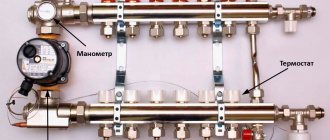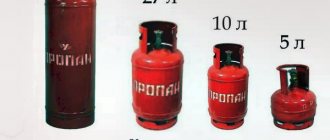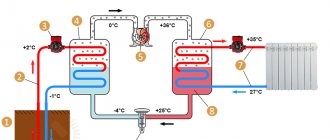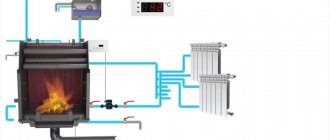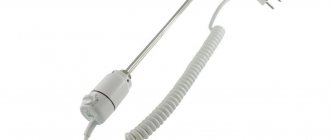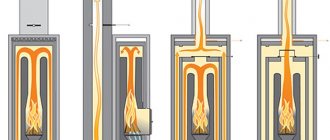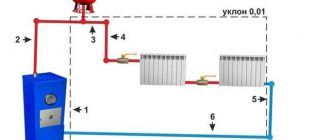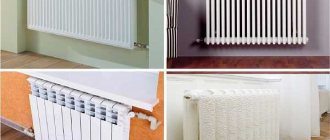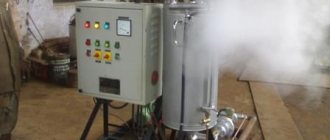In the modern world, when the reserves of traditional energy sources (gas, oil, coal) are decreasing at a high rate, and their use leads to the formation of a greenhouse effect on the planet, an increasing number of people and states in general are turning their attention to alternative types of energy.
One type of alternative energy is solar energy. Various types of solar systems are used to convert solar energy into other types that people use in everyday life.
What it is
A solar system is a complex of technical devices through which the energy of the sun in the form of solar rays is converted into thermal or electrical energy used by humans for their needs.
The solar system includes the following components:
- The receiving device (solar battery, solar collector, etc.) is an element of the solar system in which the sun's energy is converted into other types of energy;
- Devices that ensure the operating mode of the system - inverter, controller, battery (when receiving electrical energy) and heat exchanger, piping system, technical devices that ensure coolant circulation (pumps) - when receiving thermal energy.
Solar collector performance
One of the main factors influencing the performance level of solar systems is the intensity of solar radiation emitted by the Sun during daylight hours. In addition to the level of insolation (the amount of useful solar radiation per unit area), the performance of the solar collector is also influenced by secondary factors: the nominal volume of the heat storage tank, the heat exchanger material and the area of the absorbers. When choosing a solar collector for your home, pay attention to the technical characteristics: heat loss coefficients, optical efficiency parameters, as well as the aperture and total area of the solar installation. Based on these parameters, it is possible to analyze the operating efficiency and calculate the maximum permissible power. If you use a heat pump and a solar collector, you can achieve high productivity all year round.
Comments
Kinds
Depending on the purpose, operating mode and technical device, solar systems are divided into several types, these are:
- By type of energy received:
- Electrical – as a result of the operation of a set of equipment, the output is electrical energy.
- Thermal - by conversion in devices that are part of this group of solar systems, thermal energy is obtained.
- By purpose (for solar thermal installations):
- For heating;
- For hot water supply;
- Combined type (for heating and hot water supply).
- By type of coolant (for solar thermal systems):
- Using liquid coolant (water, antifreeze, etc.);
- Using air.
- By operating mode:
- Permanent action;
- Periodic action (seasonal or cyclical nature of work).
- By type of use:
- As the main source of energy received;
- As a backup source, providing coverage of part of the required power (when receiving electrical energy) and partial - when heating or receiving hot water, with thermal type solar systems.
- According to technical equipment and device:
- Voltage parameters at the solar installation output – when converting solar energy into electrical energy;
- The number of circuits that ensure the receipt and conversion of solar energy into thermal energy is single-, double- and multi-circuit.
Operating principle
The operating principles of solar systems vary depending on the type of energy received and can be formulated as follows:
- For solar power plants - the work is based on the physical properties of semiconductor materials, in which, under the influence of sunlight, a potential difference is formed between different layers of the photocell. The photocell is made on the basis of silicon, the basis of which is the formation of a “pn” junction between its layers, characterized by the “pn” conductivity of semiconductors.
- When receiving thermal energy, the sun's rays heat the coolant, which circulates in the solar collector, with subsequent transfer of the resulting heat to the heating or hot water supply system.
How much energy does the sun provide?
From the above it is clear that the solar system will work most effectively in the summer, when the sun is high and there is more sunlight.
In numbers, the energy of sunlight is characterized for the 52nd parallel and further south as: For June - about 600 W of energy per square meter. heated area in one hour.
In winter - almost ten times less. For December - 80 W/sq.m. in an hour.
In the off-season, something average - October, April - 300 - 350 W/sq.m.
But this, as indicated, is for southern latitudes. To the north there is less and less sun, and the energy received is much less.
What does this mean from a practical point of view - what can be heated?
Advantages and disadvantages
The use of solar power plants, as with any technical device, has its advantages and disadvantages, which can be formulated as follows:
- Advantages of using solar systems as an energy source:
- The sun is a source of free energy, the amount of which is disproportionately greater than human needs at the current moment in time.
- This is a renewable resource, the process of reproduction of which does not depend on the processes of its consumption and processing.
- Environmental safety of the process of obtaining and converting energy.
- The ability to create autonomous power supply systems, regardless of the type of energy received during the conversion process.
- Carrying out work in automatic mode, without constant control by the user of installations of this type.
- Disadvantages inherent in solar installations:
- Dependence on weather conditions, time of year and geographic location.
- Low efficiency - for solar systems using solar panels (electrical systems) and large overall dimensions to obtain high power, both in the production of thermal and electrical energy.
Solar systems for heating and hot water supply of a residential building
As mentioned above, one of the areas of use of solar systems is the conversion of solar energy into thermal energy, used for heating residential buildings, other buildings and structures, as well as for providing such consumers with hot water.
OLYMPUS DIGITAL CAMERA
Depending on the heating area and purpose, the configuration of such systems may vary. Some options for constructing such solar systems are discussed below.
Solar system for heating a house with an area of 100 m2
In order to select equipment to complete a solar system, determine its quantity, method and location of installation, you need to solve several organizational issues, these are:
- Find out what solar activity is at the location where the equipment is supposed to be installed.
- Determine the thermal energy needs of the house, the declared area.
- Decide in what capacity the installation will act, in the heating system of the house (stand-alone system or as an addition to other heating systems).
It should be noted right away that creating a completely autonomous heating system based on a solar installation is quite a complex task from the technical side. This is due to the cyclical nature of the solar system’s operation, when at night the process of receiving energy from an external source (the sun) stops, which requires the installation of additional thermal energy storage tanks and other energy-saving devices.
The solar system for heating a house includes:
- Solar collector - there are various types of devices, differing in design and geometric dimensions.
- A pumping station equipped with a controller regulates the operation of the system automatically.
- Boiler – storage tank, heat accumulator.
- Expansion tank – ensures the heating system operates in normal mode, regardless of the temperature of the coolant circulating in the heating system.
- Automation devices (pressure and temperature sensors).
- Hot and cold water (coolant) pipelines with shut-off elements.
Schematically, a house heating system based on a solar installation looks like this:
As a rule, the use of solar collectors allows you to reduce the costs of using other sources of heat in the spring-autumn period, when the sun is already active, and the need for heating the house still remains.
However, for a house with a total area of up to 100.0 m2, it is possible to create a completely autonomous heating system, but for this you need to select the right equipment, in accordance with the calculation that should be performed before starting work.
To calculate a solar system used to heat a house, you need to know:
- The total area of the house (number of floors), taking into account the height of the premises and their parameters (purpose - living rooms, technical and other premises).
- The number of sunny days per year (solar activity) according to weather services or given in specialized literature.
- Parameters of the coolant used in the heating system (temperature, viscosity, thermal conductivity).
The cost of a set of equipment depends on the power and type of collector, as well as the company that produces them. The price range is quite large and ranges from several tens of thousands of rubles (25,000.00 – 80,000.00) to hundreds of thousands (110,000.00 – 180,000.00).
The cost of installation, which is offered by organizations specializing in such work, also varies; on average, such work costs from 50,000.00 to 100,000.00 rubles, depending on the type of collector and its power.
The use of solar systems to create autonomous heat supply systems is possible in the southern regions, but since... This is a rather expensive undertaking, but in practice, such installations are used in this capacity quite rarely.
The seasonality of the use of heating systems also determines the power of such installations. If in winter, when solar activity is lower than in summer, the need for heating a house is maximum, and the power of the collectors is not enough to provide heat for all the existing demand, then in summer the opposite is true. The excess heat generated by the collectors must be used, which allows for the creation of two- and multi-circuit systems that allow the generated heat to be used in hot water supply systems, heating water in swimming pools, watering plants and heating in greenhouses.
Solar system for heating a house with an area of 200 m2
For residential buildings with an area of 200 m2 or more, solar systems can be used exclusively as additional to other heating systems operating on traditional energy sources.
The configuration of such systems is similar to that discussed above, the difference is that in such a system, the thermal energy storage tank is connected to another heat source.
Such a source, as in the diagram below, can be a heating boiler that uses various types of fuel (coal, gas, liquid fuel) for individual use, or a centralized heating system connected to the internal circuit of the heated house.
On average, in the spring and autumn, the use of solar power plants as an additional source of thermal energy allows reducing the load on the main energy resources used for heating the house by 30-40% of the total amount of heat consumed.
Installation features
In addition to the correct choice of equipment and competent design, qualified installation is required for flawless operation of the system. There are many subtleties, the use of which will help increase the service life of all collector elements.
The first nuance concerns the thermostatic valve, which serves as protection against burns. In standard heating systems, this element is rarely installed due to the fact that the temperature of hot water can be adjusted on the generator. Therefore, when designing a solar system, the valve is often forgotten. It is also possible to install a water heating limiter in the solar system regulator, but then the efficiency of the equipment will be significantly reduced. A tank heated to maximum temperature will provide hot water even on cloudy days.
In order for the valve to work correctly, it is installed a little further from the water heater. Close proximity provokes overheating of the unit, as a result of which hot water stops flowing into the pipeline.
The second nuance concerns the capacity of the hot water battery. It is installed in a spacious place. This is important for easy access to the tank for maintenance and repair. Often, a part of the room under the stairs or basement is selected for the tank. In this case, it is necessary to take into account the height of the ceiling. At the top of the water heater is a magnesium anode. To replace it, you will need a space above the tank of at least 60 cm. If the height does not allow for repair work, then an active electric anode should be installed at the installation stage of the system.
The third nuance concerns the installation of an expansion tank, which compensates for all the coolant displaced from the collectors during stagnation. This takes into account the thermal expansion of the liquid. Correct functioning of the tank ensures its correct location. Installation is carried out below the level of the pump group. If the container is placed above the pumps, the membrane will become vulnerable to high temperatures, causing an air bubble to form on it. It dries out the rubber, impairing its elasticity and other physical properties. This leads to rapid wear of the membrane.
The fourth nuance concerns the connection of the solar circuit to the battery tank. Due to the fact that heat always rushes upward, it is necessary to make a connection from below, creating a barrier to the warm flow. This is achieved by connecting pipes to the water heater, creating a so-called loop (thermal loop). If you ignore the recommendation, the temperature of the water in the tank will drop by at least 2-8 degrees overnight.
The fifth point concerns the check valve. In its absence, all the heat accumulated during the day in the solar circuit will dissipate through the collectors at night. To prevent wastage of resources, it is recommended to install a check valve in the lower connection of the battery tank.
Solar water heating system
When using solar collectors in hot water supply systems and water heating networks in swimming pools, the network configuration is similar to heating networks, with the only difference being that it can be a completely separate system or part of the overall heating system of the house.
The quality of the solar system depends on the number of circuits installed during its development. The diagram above shows the option of installing a hot water supply system in the general heating system of a house with an area of 200 m2 or more, when the solar system is an additional source of heat.
On a note
European countries are the undisputed leaders in the development of new solar heating systems, but are far behind China in the volume of commissioning of new solar installations. The Celestial Empire today accounts for 78% of solar collectors commissioned out of the total number produced in the world. Europe accounts for only 9%, Turkey and Israel - 8% and other countries - 5%. It is not surprising that it is now easier and cheaper to buy Chinese solar systems in Russia, especially since their quality indicator is no worse.
Mathematical modeling of the simplest solar water heating installation, carried out at the Institute of High Temperatures of the Russian Academy of Sciences using modern software and data from a typical weather year, showed that in the real climatic conditions of Russia it is advisable to use solar water heaters.
Thus, for installing a system with a ratio of the solar collector area to the volume of the storage tank of 2 m2/100 l, the probability of daily heating of water to a temperature of at least 37°C is 50-90%, to a temperature of at least 45°C - 30-70 %, up to a temperature of at least 55°C - 20-60%. The maximum probability values apply to the summer months.
Solar energy is widely used for economic needs in Europe. Thus, the total area of solar collectors installed in the EU countries reached 13,960,000 sq.m., and in the world exceeded 150,000,000 sq.m.. The annual increase in the area of solar collectors in Europe averages 12%, and in some countries reaches the level 20-30% or more. In terms of the number of collectors per thousand inhabitants, the world leader is the Republic of Cyprus, where 90% of houses are equipped with solar installations (there are 615.7 m2 of solar collectors per thousand inhabitants), followed by Israel, Greece and Austria. The absolute leader in the area of installed collectors in Europe is Germany - 47%, followed by Greece - 14%, Austria -12%, Spain - 6%, Italy - 4%, France - 3%.
Currently operating in Europe:
- 10 solar heating systems with collector areas from 2400 to 8040 m2;
- 22 systems with collector areas from 1000 to 1250 m2;
- 25 systems with collector areas from 500 to 1000 m2.
DIY solar system
If you have skills in working with various hand tools, basic knowledge of the physical properties of various substances, as well as free time, you can make a solar system with your own hands.
There may be several options for creating and constructing such an installation, such as assembling a convector from factory components or making it entirely from improvised means, or creating simple installations that operate on the properties of liquids and atmospheric air.
These include the design options discussed below.
Thermosiphon solar system
Thermosiphon solar installation is the simplest system that operates on the properties of liquid (air) to circulate in the system without installing special equipment (pump), which is due to their natural convection. This system can be used in hot water supply systems and pool water heating systems.
The density of thermal and cold water differs, which determines its movement in a closed space - hot water rises up, cold water goes down. The operation diagram of the thermosiphon system is shown in the following diagram:
To make such a system yourself, you will need:
- Two containers (barrels), one of which serves as a cold water storage tank and is located slightly above the convector and the second container, which serves as a heated water distributor.
- A system of pipes that connects all structural elements into a single whole.
- A convector, which is assembled from improvised means.
To make a convector, you can use plastic bottles from which the battery is assembled. There can be several similar batteries, and they are connected to each other in series (as in the diagram above).
The assembled batteries from bottles can be placed in a separate housing, in which insulation is placed for greater absorption of solar heat, although it can be done without it.
The connection of the bottles must be airtight to prevent water leakage at the points of their connection.
In addition to plastic bottles, you can use a water hose laid as a snake in a mounted housing or other available materials that can heat up under the influence of sunlight and which can be hermetically connected to each other.
The convector body is made from available materials (wood, plastic, metal or other profile), after which the assembled structure is placed in the most illuminated area and all its elements are combined into a single whole.
Cold water is poured into the storage tank and after a certain time, heated water can be dispensed from the distributor tank.
Air solar system
One of the simple designs that you can also make yourself is an air solar system. This installation can be used for partial heating in the southern regions of the country, where the air warms up significantly and the need for heating housing is small.
The principle of operation of the air collector is similar to the principle of operation of the thermosiphon system discussed earlier. The only distinctive feature is the coolant, which is reflected in the design of the collector.
In order to make your own air collector, you can use available materials, these are: water pipes or tin cans, profiled metal sheet or other material with a profile section.
The operating diagram of the air collector is shown in the diagram:
The collector body is made from available materials, as in the case of a thermosiphon system. Using a metal profile, tin cans or by using water pipes, ribs are created that divide the air flow into individual components.
Insulation is placed inside the housing, and on the outside, the housing is covered with glass, which serves as a heat insulator for the internal air from the outside environment.
When using a metal profile or other structure, as in the diagram above, ribs separating air flows can be combined with a panel that is a solar heat receiver. When using cans and water pipes, they perform this function themselves.
At the ends of the housing, places are provided for attaching the collectors to each other (if there are several of them) and for attaching them to air ducts that provide the supply of cold air and the removal of warm air.
The simplest options for solar collectors for a summer shower
The elementary nature of the most unassuming options for solar collectors does not mean they are ineffective. Despite the sometimes flimsy, unattractive design, often assembled from rubbish, they perform their functions.
Recommendations:
- It is advisable to place the absorber in a sealed case, at least wrap it in polyethylene;
- the front cover should be transparent, and if it is part of the absorber, then you can use a dark or matte material recommended for other parts;
- the back wall must be treated specially - black material or foil is placed on it to reflect light and retain heat inside;
- the best material for the coil, body, and parts is metal. In the sun, it will not just heat up, but glow.
However, even if you do not adhere to some of the above tips, the collector will perform its functions. Let's look at some striking examples.
Simple rubber hose, polypropylene pipes in a sealed housing:
The last photo above is an excellent solution - the black limited space creates the effect of an oven, the coil is thick, its walls are thin, it heats up quickly.
From PET bottles, carboys
An elementary method is solar collectors made from plastic bottles. Of course, it is highly recommended to paint them black; even a regular can of spray paint will do. In one embodiment, the bottles are used as a casing for the coil pipes.
System diagram with PET bottles:
Here plastic bottles with a black seal act as a casing for the coil:
Where can I buy
Solar systems in general and their components are a specific product, for the purchase of which it is best to contact an organization that specializes in the sale of goods in this energy sector.
The best option, in this case, is to find a dealer of a company producing solar systems and enter into a supply agreement.
If it is impossible to do this, and if you want to reduce the cost of purchasing equipment, you can turn to the Internet, where there is a fairly large number of offers for the sale of solar installations, both complete sets and their individual elements.
Tips for use
The operation of solar installations is carried out in accordance with the design features. The main task of the owner is to maintain cleanliness and remove dust or snow. In some cases , it is necessary to periodically change the position of the panels in accordance with seasonal changes in the location of the Sun. Repair or replacement of individual elements is carried out as the need arises; all work can be performed either independently or with the help of external specialists.
Use in Crimea
Crimea is a region of our country located in a zone of active solar radiation, so special attention has always been paid to the use of solar systems here.
On an industrial scale, solar energy in Crimea developed as an energy system providing electrical energy to industrial enterprises and household consumers. 13 solar power plants with a total installed capacity of more than 280.0 MW have been launched and are successfully operating on the peninsula.
The production of thermal energy through the use of solar systems is also widely used both in individual industrial enterprises and in the private sector, where they are used for heating and hot water supply.

